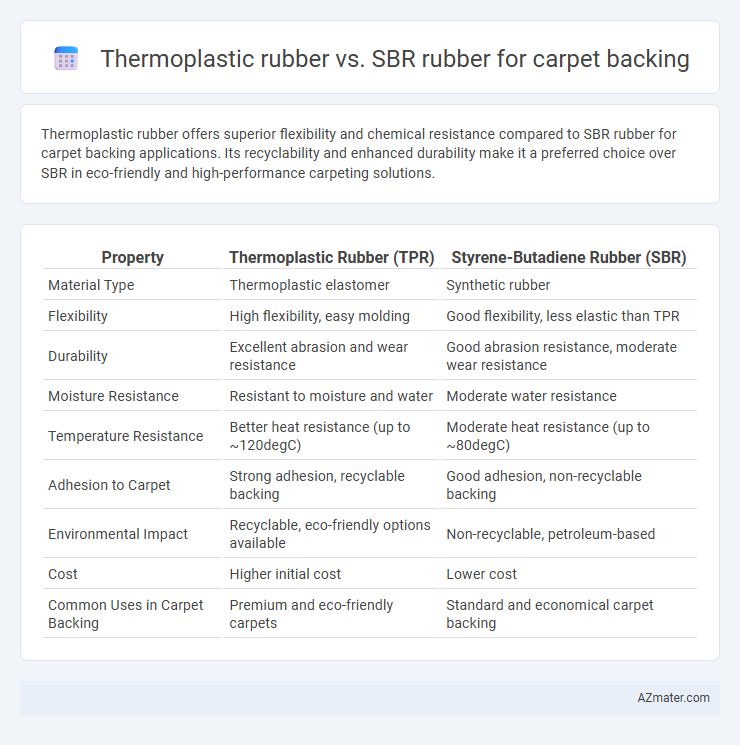Thermoplastic rubber offers superior flexibility and chemical resistance compared to SBR rubber for carpet backing applications. Its recyclability and enhanced durability make it a preferred choice over SBR in eco-friendly and high-performance carpeting solutions.
Table of Comparison
| Property | Thermoplastic Rubber (TPR) | Styrene-Butadiene Rubber (SBR) |
|---|---|---|
| Material Type | Thermoplastic elastomer | Synthetic rubber |
| Flexibility | High flexibility, easy molding | Good flexibility, less elastic than TPR |
| Durability | Excellent abrasion and wear resistance | Good abrasion resistance, moderate wear resistance |
| Moisture Resistance | Resistant to moisture and water | Moderate water resistance |
| Temperature Resistance | Better heat resistance (up to ~120degC) | Moderate heat resistance (up to ~80degC) |
| Adhesion to Carpet | Strong adhesion, recyclable backing | Good adhesion, non-recyclable backing |
| Environmental Impact | Recyclable, eco-friendly options available | Non-recyclable, petroleum-based |
| Cost | Higher initial cost | Lower cost |
| Common Uses in Carpet Backing | Premium and eco-friendly carpets | Standard and economical carpet backing |
Introduction to Carpet Backing Materials
Thermoplastic rubber (TPR) offers superior flexibility and durability ideal for carpet backing, enhancing resistance to wear and moisture compared to traditional materials. SBR rubber, or styrene-butadiene rubber, provides excellent abrasion resistance and cost-effectiveness, making it a common choice for heavy-traffic carpet backings. The selection between TPR and SBR depends on factors like expected traffic, environmental exposure, and budget constraints, affecting overall carpet performance and longevity.
What is Thermoplastic Rubber?
Thermoplastic rubber (TPR) is a versatile elastomer combining the properties of rubber with the processability of thermoplastics, making it ideal for carpet backing due to its flexibility, durability, and ease of recycling. Compared to styrene-butadiene rubber (SBR), TPR offers superior resistance to abrasion, temperature variations, and chemical exposure, enhancing carpet longevity and performance. Its ability to be remolded multiple times without degradation provides sustainable advantages over SBR, which is a synthetic rubber primarily valued for its cost-effectiveness but less adaptable in dynamic environments.
What is SBR Rubber?
SBR rubber, or Styrene-Butadiene Rubber, is a synthetic rubber commonly used for carpet backing due to its excellent abrasion resistance and cost-effectiveness. Its chemical composition provides good binding strength and durability, making it suitable for high-traffic areas. Compared to thermoplastic rubber, SBR offers superior flexibility but may have lower heat resistance and aging stability.
Key Differences Between Thermoplastic Rubber and SBR
Thermoplastic rubber (TPR) offers superior flexibility and recyclability compared to SBR rubber, making it ideal for eco-friendly carpet backing applications. SBR rubber provides excellent abrasion resistance and cost-effectiveness but lacks the easy processability and reusability found in TPR. Key differences include TPR's thermoplastic nature allowing melting and reshaping, whereas SBR is a vulcanized synthetic rubber with better heat resistance but limited recyclability.
Durability and Performance Comparison
Thermoplastic rubber (TPR) offers superior durability and flexibility compared to SBR rubber, making it more resistant to wear, tear, and environmental stress in carpet backing applications. SBR rubber provides good abrasion resistance and cost-effectiveness but tends to degrade faster under prolonged UV exposure and extreme temperatures, impacting long-term performance. The enhanced elasticity and resilience of TPR contribute to better dimensional stability and longer lifespan for carpets, especially in high-traffic or commercial settings.
Environmental Impact and Sustainability
Thermoplastic rubber (TPR) offers enhanced environmental benefits over styrene-butadiene rubber (SBR) for carpet backing, as TPR is fully recyclable and generates less waste during production. SBR, derived from petrochemical sources, typically involves higher carbon emissions and is less biodegradable, contributing to greater environmental impact. Sustainable carpet backing solutions increasingly favor TPR due to its potential for reuse, lower VOC emissions, and alignment with circular economy principles.
Cost Analysis: TPR vs SBR for Carpet Backing
Thermoplastic rubber (TPR) generally incurs higher initial costs compared to Styrene-Butadiene Rubber (SBR) due to its advanced manufacturing process and superior durability properties. SBR offers a more cost-effective solution for carpet backing, balancing acceptable performance with lower raw material and production expenses. Evaluating the total cost of ownership reveals that TPR may reduce replacement frequency and maintenance costs, while SBR provides a budget-friendly alternative for large-scale, cost-sensitive applications.
Installation and Maintenance Considerations
Thermoplastic rubber (TPR) used for carpet backing offers superior flexibility and ease of installation due to its lightweight and pliable nature, reducing labor time and ensuring a snug fit on various floor types. In contrast, Styrene-Butadiene Rubber (SBR) requires more curing time and may demand specialized adhesives, making installation potentially more complex and time-consuming. Maintenance of TPR-backed carpets is simplified by its resistance to moisture and mold, whereas SBR can absorb water, increasing the risk of degradation and necessitating more frequent inspections to maintain carpet integrity.
Applications and Suitability in Carpet Backing
Thermoplastic rubber (TPR) offers superior elasticity and excellent resistance to wear, making it ideal for high-traffic carpet backing applications where durability and flexibility are critical. Styrene-butadiene rubber (SBR) provides strong abrasion resistance and cost-effective performance, suitable for budget-friendly carpet backings with moderate traffic demands. TPR's recyclability and stronger bonding properties enhance carpet longevity, while SBR's water resistance supports indoor environments with occasional moisture exposure.
Choosing the Best Rubber Backing for Your Carpet
Thermoplastic rubber (TPR) offers superior flexibility, durability, and resistance to moisture compared to Styrene-Butadiene Rubber (SBR), making it an excellent choice for carpet backing in high-traffic areas. SBR rubber is cost-effective and has good abrasion resistance but tends to degrade faster under UV exposure and moisture. Selecting TPR backing ensures longer-lasting performance and enhanced dimensional stability for carpets subjected to frequent cleaning and heavy use.

Infographic: Thermoplastic rubber vs SBR rubber for Carpet backing
 azmater.com
azmater.com